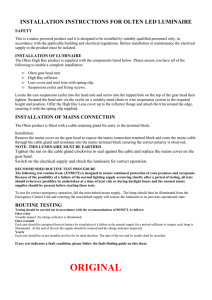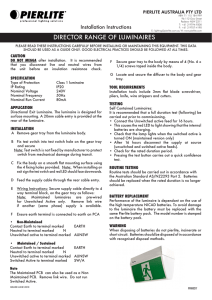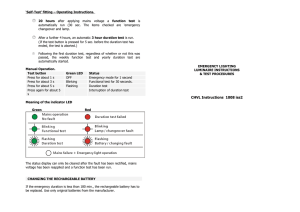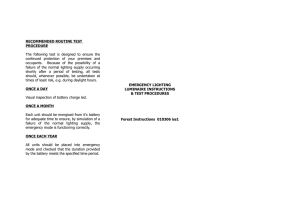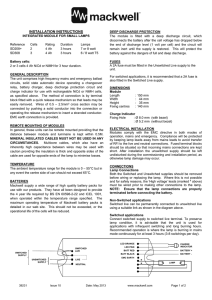Eden LED Bulkhead Installation Instructions
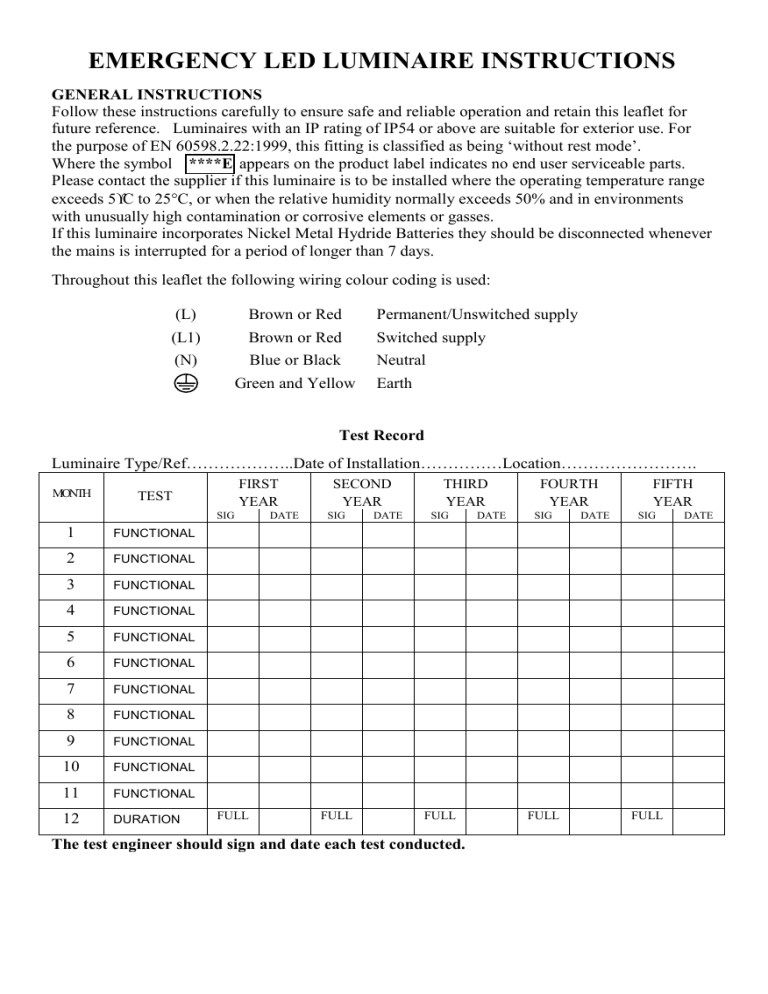
EMERGENCY LED LUMINAIRE INSTRUCTIONS
GENERAL INSTRUCTIONS
Follow these instructions carefully to ensure safe and reliable operation and retain this leaflet for future reference. Luminaires with an IP rating of IP54 or above are suitable for exterior use. For the purpose of EN 60598.2.22:1999, this fitting is classified as being ‘without rest mode’.
Where the symbol ****E appears on the product label indicates no end user serviceable parts.
Please contact the supplier if this luminaire is to be installed where the operating temperature range exceeds 5
°
C to 25°C, or when the relative humidity normally exceeds 50% and in environments with unusually high contamination or corrosive elements or gasses.
If this luminaire incorporates Nickel Metal Hydride Batteries they should be disconnected whenever the mains is interrupted for a period of longer than 7 days.
Throughout this leaflet the following wiring colour coding is used:
(L) Brown or Red Permanent/Unswitched supply
(L1) Brown or Red Switched supply
(N) Blue or Black Neutral
Green and Yellow Earth
Test Record
Luminaire Type/Ref………………..Date of Installation……………Location…………………….
MONTH TEST
FIRST SECOND THIRD FOURTH FIFTH
1 FUNCTIONAL
SIG
YEAR
DATE
YEAR
SIG DATE
YEAR
SIG DATE
YEAR
SIG DATE
YEAR
SIG DATE
2 FUNCTIONAL
3 FUNCTIONAL
4 FUNCTIONAL
5 FUNCTIONAL
6 FUNCTIONAL
7 FUNCTIONAL
8 FUNCTIONAL
9 FUNCTIONAL
10 FUNCTIONAL
11 FUNCTIONAL
12 DURATION
FULL FULL FULL
The test engineer should sign and date each test conducted.
FULL FULL
MAINTAINED OPERATION
Both Mains Supplies Healthy
LED Lamp(s) operate from the normal mains supply that can be switched and an additional unswitched mains supply charges the battery pack (charge indicator LED lights to indicate the battery pack is charging).
Unswitched or both Mains Supply Failures (or optional push to test switch operated)
LED Lamp(s) comes on in emergency and the charge Indicator LED goes out.
NON-MAINTAINED OPERATION
Unswitched Supply Healthy
LED Lamp(s) not illuminated (charge indicator LED lights to indicate the battery pack is charging).
Unswitched Supply Failed (or push to test switch operated)
LED Lamp(s) operate in emergency and the charge indicator LED goes out.
RECOMMENDED ROUTINE TEST PROCEDURE
The following test routine from EN50172 is designed to ensure continued protection of your premises and occupants. Because of the possibility of a failure of the normal lighting supply occurring shortly after a period of testing, all tests should (wherever possible), be undertaken at a time of least risk or during daylight hours.
Normal mains supplies should be present before starting these tests and any LED lamps that are showing signs of ageing should be replaced prior to continuing with the test.
To test for correct emergency operation, fail the unswitched mains supply, where a switched supply is present this should also be isolated. The LED lamp should then be illuminated from the
Emergency Control Unit.
Restoring the unswitched supply will restore the luminaire to its previous operational state.
If either test indicates a fault condition, follow the fault finding guide instructions on this sheet.
Once a day
Visually inspect the charge indicator LED is illuminated.
Once a month
Each unit should be energised from its battery by simulation of a failure at the normal supply for a period sufficient to inspect each LED lamp is illuminated. At the end of the test the supply should be restored and the charge indicator LED inspected.
Yearly
Each unit should be as per monthly test but for its rated duration. The date of the test and its results shall be recorded.
SAFETY
Follow the appropriate national wiring regulations; if in doubt consult a qualified electrician.
Disconnect the mains supplies before removing the diffuser or panels prior to carrying out any maintenance or replacements of LED lamp(s).
This product must not be modified in any way, as this will negate any Safety Mark or approvals, and may render the product unsafe. The product must be installed in accordance with these instructions.
Suitable for use in ambient temperatures over the range 5
°
C to 25°C.
The luminaire should not be covered with any heat insulating material and the airflow around it should not be restricted. Note any minimum distances to adjacent surfaces.
The luminaire should be connected into the lighting supply circuit, or should be on a dedicated circuit, fused at 5A.
To ensure good electrical contact, terminals must be screwed firmly onto the copper conductors and tinned wire strand cables should be avoided.
INSTALLATION INSTRUCTIONS
1.
Remove the cover from emergency luminaire.
2.
Connect the mains cable(s).
The supply for a non-maintained emergency circuit must be unswitched and is connected to the unswitched input.
The supply to a non-emergency circuit can be switched and is connected to the switched input.
If a single unswitched supply is used for both emergency and normal use a link should be connected between the unswitched supply and switched supply terminals.
3.
Mark the battery pack with date of installation.
4.
Connect the battery to the module.
5.
Replace the emergency luminaire cover or diffuser.
For testing purposes a Fused Spur or Keyswitch should be included in the unswitched supply.
WARNING
Failure to comply with these installation instructions may result in irreparable damage to the emergency control unit or luminaire.
DO NOT INSULATION TEST the lighting system with the emergency control units installed.
FAULT FINDING
1. Charge indicator LED not illuminated a) Check the battery is connected to the emergency control unit. b) A.C. unswitched supply interrupted – restore supply. c) Battery fault causing charge circuit to shut down (self-resetting) – replace the battery and check for correct ambient temperature. d) Emergency control unit fault – contact your supplier.
2. Unit not meeting required emergency duration period a) Unit operating outside temperature limits – check ambient temperature. b) Unit may need cycle discharge – recharge for 24 hours then re-test. If the duration has improved repeat the procedure until full duration is achieved or the battery pack needs replacing – contact your supplier.
3. No light output at all a) Check the charge LED is lit when the A.C unswitched mains supply is on. b) Check the LED lamp and ensure it is correctly connected to the control gear. c) Check all wiring and connections. d) Check the battery pack on load (discharge condition) using a voltmeter. The nominal battery
voltage is shown on the battery label.
DISPOSAL
The disposal of large quantities of electrical equipment (EEE) is subject to European,
National and Local Authority regulations (WEEE).
Products displaying the ‘wheelie bin’ symbol indicate the product should not be disposed of in the normal waste stream.
PERFORMANCE AND WARRANTY
In place of any other conditions or warranties, whether imposed by Statue or implied by Common
Law we undertake as follows:-
(A) We will repair or, if necessary, replace free of charge any materials or work found to be defective in our 'Emergency Lighting Control Gear' and brought to our attention within 12 months from the date of supply. This warranty will only be valid if the Emergency Luminaire has been used with the correct battery pack and mains supply and has remained unmodified and used as per this instruction leaflet and our literature and for its intended purpose.
(B) The batteries are guaranteed for 12 months but are expected to have a life of at least 4 years if used within the specified temperature limits.
(C) We shall not be liable for any consequential loss or damage caused directly or indirectly by any defect or otherwise.
All information is given for guidance only and we reserve the right to change the characteristics of products without notice.
28598/9
